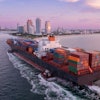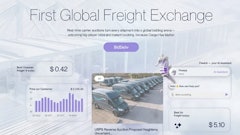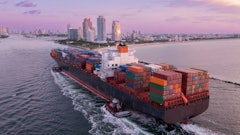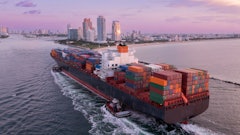
VessbelBot’s latest study of 73,353 containership voyages completed by 4,750 vessels between July and September 2025 reveals critical patterns in containerships fleet performance as the industry approaches crucial compliance deadlines.
The report, "Decoding Maritime Emissions, Q3 2025: Containership Emissions and Traffic on the Rise," shows total containership emissions reached 50.3 million tons in Q3 2025, remaining virtually unchanged (-0.2%) compared to Q3 2024 despite a 2.3% increase in voyages. Average well-to-wake emissions intensity improved to 195.9 g CO2e/TEU km, down 1.6% year-over-year, driven by longer steaming times and reduced port dwell times.
"The regulatory landscape is growing more complex rather than simplified, as evidenced by the European Parliament rejection of the Omnibus simplification effort and the IMO's postponement of the Net-Zero Framework," says C. Komodromos, CEO and founder of VesselBot. "With CBAM certification requirements beginning in weeks and Scope 3 reporting deadlines approaching, maritime stakeholders require granular, real-time data to navigate diverging compliance requirements across multiple jurisdictions. Industry averages fail to capture the significant performance variations between vessel sizes, ages, and routes that directly impact both compliance costs and operational efficiency. VesselBot's voyage-level analysis reveals that containership intensity can vary significantly depending on vessel characteristics; insights that are invisible in aggregated data but critical for strategic decision-making in an increasingly carbon-constrained environment."
Key takeaways:
· Direct China-U.S. voyages showed pronounced volatility, declining 3% in the first nine months of 2025 but spiking 15% in July before dropping 10% in September. China's retaliatory port fees targeting U.S.-owned, operated, or built vessels introduce additional complexity to carrier deployment strategies.
· Well-to-wake emissions intensity varies dramatically by vessel size, from 252.1 g CO2e/TEU km for Feeder vessels (up to 2,999 TEU capacity) to 61.4 for Very Large Container Ships (at least 17,000 TEU capacity). Feeder vessels completed 62.1% of all Q3 voyages yet accounted for only 10.3% of total TEU km, while VLCS completed just 2% of voyages, accounting for 17.2% of total TEU km, which reflects their significantly higher efficiency levels.
· Chinese-built vessels completed 36% of Q3 voyages, while 53.1% of vessels under 5 years old have been built from Chinese shipyards. South Korean-built vessels carried out 24.6% of all Q3 containership voyages, but 41.3% of all VLCS. South Korean-built vessels' voyages recorded the lowest emissions intensity at 152.7 g CO2e/TEU km due to larger capacities and long-haul trade deployment.
· Major fronthaul trades demonstrate the importance of route-level analysis, with Asia-Northern Europe voyages averaging an intensity of 55.3 g CO2e/TEU km and a duration of 30.6 days In contrast, industry-wide average steaming time was only 3.5 days, highlighting how aggregate metrics obscure critical operational differences.















![Pros To Know 2026 [color]](https://img.sdcexec.com/mindful/acbm/workspaces/default/uploads/2025/08/prostoknow-2026-color.mduFvhpgMk.png?ar=16%3A9&auto=format%2Ccompress&bg=fff&fill-color=fff&fit=fill&h=135&q=70&w=240)


